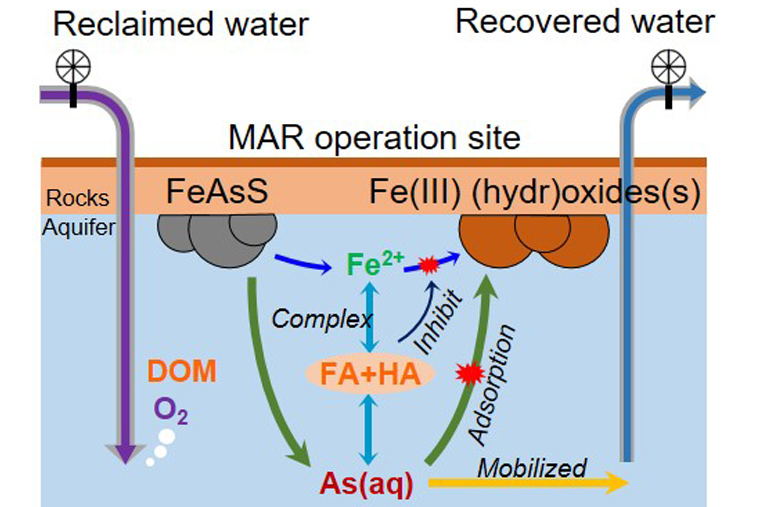Jan 10 2020
Reclaimed water is injected into depleted aquifers by many municipalities to replenish groundwater levels. The injected water is purified through secondary wastewater treatment, and in certain cases, treated using tertiary processes and can be sufficiently clean to be consumed directly.
 In this diagram, Young-Shin Jun, professor of energy, environmental and chemical engineering at the McKelvey School of Engineering, demonstrates how it is that the perfectly potable water used to recharge an aquifer can become contaminated with dangerous levels of arsenic. Image Credit: Jun Lab.
In this diagram, Young-Shin Jun, professor of energy, environmental and chemical engineering at the McKelvey School of Engineering, demonstrates how it is that the perfectly potable water used to recharge an aquifer can become contaminated with dangerous levels of arsenic. Image Credit: Jun Lab.
Within the aquifer, the original water is chemically stable, remaining in equilibrium with the surrounding rocks. This water is gradually recharged through water infiltration, which is a natural processes.
However, when the consumption of groundwater becomes greater than the restoration made by natural processes, engineered recharging with reclaimed, purified water will be required. However, the reclaimed water occasionally becomes polluted over time.
Now, a team of researchers in the McKelvey School of Engineering at Washington University in St. Louis has discovered how the drinkable water used to replenish a depleted aquifer, can become polluted with unsafe arsenic levels.
The research team was headed by Young-Shin Jun, professor of energy, environmental, and chemical engineering, and also by Xuanhao Wu, a doctoral student working in Jun’s laboratory. The study was published in the Environmental Science and Technology journal.
In a controlled recharge of aquifers, “we continuously draw down the aquifer, but we never refill it enough,” stated Jun.
Our population can grow quickly and our lifestyle becomes more water-dependent but the natural refilling process is slow. So water management practice has engineered a way to inject water to compensate for our consumption and achieve environmental sustainability.
Young-Shin Jun, Professor, Department of Energy, Environmental, and Chemical Engineering, Washington University in St. Louis
There are several significant reasons to keep aquifers full. For instance, salty seawater on coasts can recharge a depleted aquifer. This creates a catastrophic situation, not only for the ecosystem, but also for the crops fed by the aquifer.
If the depleted zone continues to remain vacant, sinkholes can materialize and the land can potentially subside. Therefore, recharging the aquifers to offer potable water is a regular practice in regions spanning from Florida to California.
However, approximately a decade ago, Jun came across a puzzling situation when working on a controlled recharge of aquifers with the Environmental Protection Agency (EPA).
When we injected the water, it was good, but when we withdrew it, it was bad, tainted with arsenic. What was wrong?
Young-Shin Jun, Professor, Department of Energy, Environmental, and Chemical Engineering, Washington University in St. Louis
It was eventually found that while the water being filled into the aquifer was often sufficiently clean to drink directly, it was introducing oxygen to the aquifer, which was something new.
“By injecting reclaimed water, we are triggering oxidative dissolution of sulfide minerals in the aquifer, which were stable at low oxygen levels,” Jun added.
More specifically, Jun looked at a mineral called arsenopyrite (FeAsS) that dissolves into sulfur, iron, and, most importantly, arsenic. However, another reaction occurs even before the arsenic reaches problematic levels.
“The iron precipitates into iron oxides or hydroxides,” added Jun. The arsenic adheres, or adsorbs, to hydroxides or iron oxides, which are insoluble and prevent arsenic from entering into the water. Yet, there is another significant factor.
Dissolved organic matter (DOM)—carbon-containing compounds—drastically alters the situation. “With high levels of organic compounds, we found the precipitation reaction is suppressed,” Jun further added.
When precipitation of hydroxides or iron oxides is inhibited, the arsenic no longer adsorbs adequately and instead continues to remain in the water. This is more than an experimental exercise in laboratory settings, Jun pointed out quickly.
“This is not a potential future problem,” Jun added, observing that the use of reclaimed water is currently the actual practice. “When thinking about water reclamation from aquifers, we need to consider the roles of organic matter,” she stated.
We have to take into account the DOMs in injected water to make sure they do not trigger more mobilization of toxins. The roles of DOMs in managed aquifer recharge should be included in the predictive models. Knowing how water chemistry alters the chemical reactions in an aquifer will enable us to fully utilize the water, rather than discarding it as waste.
Young-Shin Jun, Professor, Department of Energy, Environmental, and Chemical Engineering, Washington University in St. Louis
“Please keep in mind that there is only one kind of water in the world. All water—drinking water, seawater, groundwater, wastewater, stormwater, greywater, and more—is simply ‘water’. Keeping it safe and sustainable is our continuing homework,” concluded Jun.
The study was funded by the National Science Foundation, and the U.S. Department of Energy, Office of Science, Office of Basic Energy Sciences.